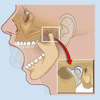Osteopathy, essential after wisdom teeth extraction
The extraction of wisdom teeth is a technical procedure that requires a large or even too large opening of the jaw... The duration of the procedure and the technique itself can be a source of many problems:
- slamming of the jaw
- headaches
- dizziness
- tinnitus
- pain in the jaw,
- postural disorders, etc.
It is therefore recommended to consult an osteopath a few weeks after the wisdom teeth extraction procedure in order to limit these disorders
Reminder on the anatomy of the teeth and jaw
Wisdom teeth

Wisdom teeth are the teeth at the very back of the jaw, next to the molars. They are numbered 18, 28, 38 and 48 and often do not appear in some people. In other cases, these teeth come out partially.
It is possible to remove them, but this procedure is not always necessary. It is only recommended when wisdom teeth are likely to disrupt the alignment of the teeth or cause oral discomfort. They are also removed when they are damaged or present other types of problems.
The mandible and its joints: the TMJ or Temporomandibular Joint

The bone that makes up the jaw is called the mandible. This part of the body is also composed of two TMJs or Temporomandibular Joints that connect the temporal bone to the mandibular condyle.
At the level of the TMJ, many muscles are located. These include the pterygoid, temporal and masseter muscles. There is also a small cushion called the meniscus between the temporal and the mandible.
It is the whole of these components which form the articulation of the jaw which makes it possible to open and close the mouth but also to chew.
Here are the movements allowed by the jaw:
- Opening
- Closing
- Left and right diductions
- Retropulsion
- Antepulsion
It is therefore the most solicited joint of the body and it is necessary to avoid bad constraints.
Removing wisdom teeth

There are several methods of wisdom tooth extraction, including several types of anesthesia:
- local anesthesia
- general anesthesia.
The dentist and the patient can discuss and choose the best approach. In any case, it is important to open the mouth as much as possible in order to facilitate the tooth extraction at the back. These are located after the molars.
This procedure can be the cause of jaw dislocation, especially in the case of a general anesthesia. Indeed, the completely anesthetized patient will not be able to hold the opening forced by the dentist, the risk of dislocation of the jaw is thus much higher.
In some cases, occasional discomfort is common after wisdom teeth removal. Even if the joints are not dislocated, they cause us various discomforts. These include muscle contractures or excessive stretching of the TMJ ligaments.
Consult an osteopath after the dentist's intervention

It is recommended that you make an appointment with an osteopath after your wisdom teeth are removed. However, wait up to 2 or 3 weeks for your cheeks to deflate and the gums to start healing.
Your osteopath will allow your joints to regain their mobility. You will thus avoid various constraints such as pain during chewing, tinnitus or posture and sleep disorders. Indeed, many posture sensors are located in the jaw, an imbalance of the latter will affect the rest of the body.
In addition to working on the temporomandibular joint, the osteopath will also intervene on the parts of the body such as the cervicals, the dorsal vertebrae, but also the entire muscular and fascial system related to this area in order to treat the repercussions.

